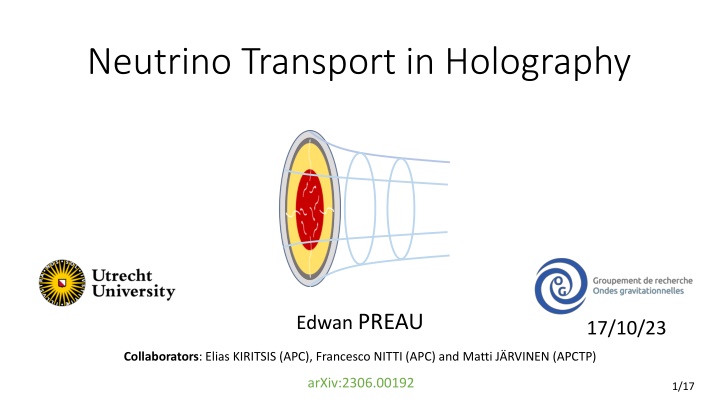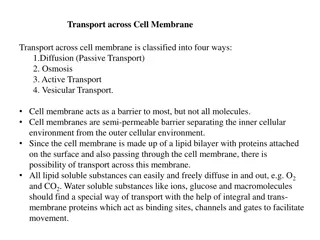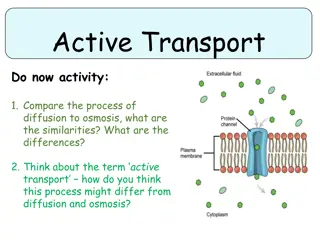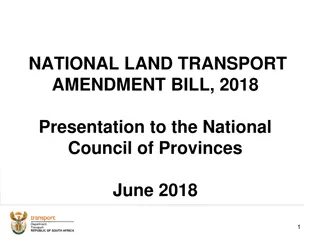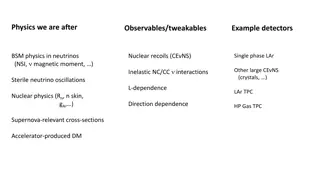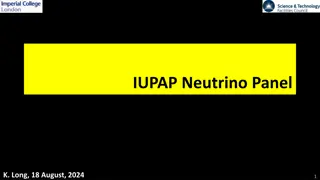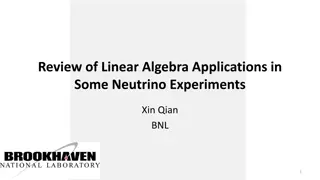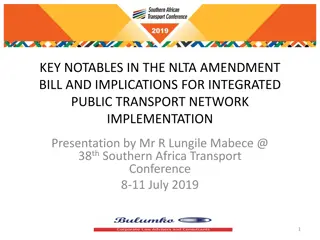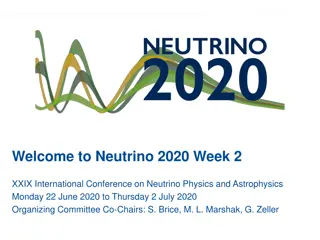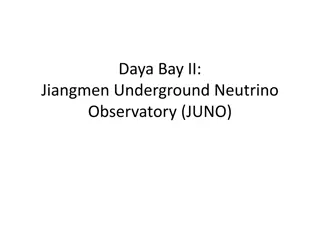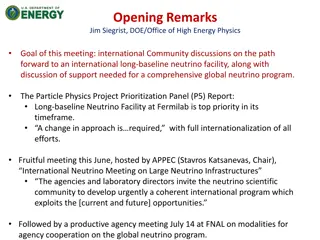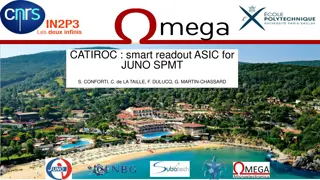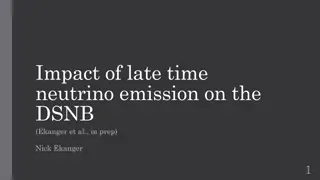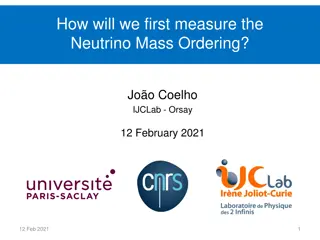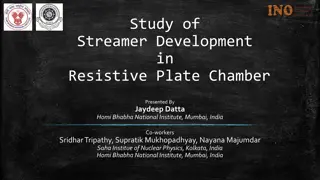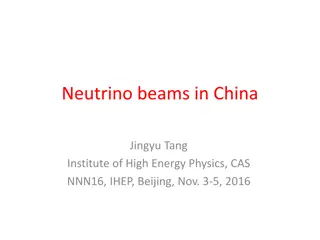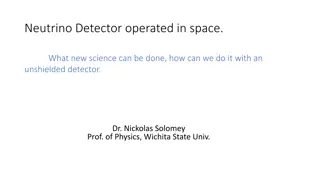Neutrino Transport in Holography Research Study
This research study delves into the realm of neutrino transport in holography, focusing on the interaction of neutrinos with dense QCD matter in the core. Motivations, formalisms, holographic set-up, and the holographic correspondence are explored using a toy model of quark matter in 4SYM and utilizing the holographic dictionary. The study aims to compute holographic QCD at finite temperature and density, employing a bottom-up holographic model with chiral currents to understand strongly-coupled quark matter in equilibrium states at finite dimensions.
Download Presentation

Please find below an Image/Link to download the presentation.
The content on the website is provided AS IS for your information and personal use only. It may not be sold, licensed, or shared on other websites without obtaining consent from the author.If you encounter any issues during the download, it is possible that the publisher has removed the file from their server.
You are allowed to download the files provided on this website for personal or commercial use, subject to the condition that they are used lawfully. All files are the property of their respective owners.
The content on the website is provided AS IS for your information and personal use only. It may not be sold, licensed, or shared on other websites without obtaining consent from the author.
E N D
Presentation Transcript
Neutrino Transport in Holography Edwan PREAU 17/10/23 Collaborators: Elias KIRITSIS (APC), Francesco NITTI (APC) and Matti J RVINEN (APCTP) arXiv:2306.00192 1/17
Motivation o Neutrino (?) radiation is the main mechanism for Neutron Star (NS) cooling o Requires the knowledge of ? interaction with dense QCD matter in the core : ? ? & ? ??/???/? 2/17
Motivation ?in the dense o Computing ??/???/? strongly-coupled QCD matter is a difficult problem o We consider the holographic approach ?in Problem : compute ??/???/? holographic QCD at finite T and ?? This work : simplest toy model (quark matter in ? = 4 SYM) 3/17
Formalism for neutrino transport The transport of neutrinos is described by the Boltzmann equation obeyed by the ? distribution function ???,?;?? 1 (?? ?)?? ? ?? 1 ?? ?? . ? ?? Emissivity Mean Free Path ? + ? We focused on charged current interactions : ??+ ? ?) in the electro-weak interaction At order ?(?? 3 dk? 2?3kins? ? stats Im ? ?? ?? 2 + ? , ???? = ?? Dense QCD ?? ??,?? ??,?? ?? ??? 4/17
The holographic correspondence ???,? Strongly-coupled quantum field theory in 4D Weakly-curved classical gravitational theory in 5D The boundary of the 5D space (bulk) is the 4D space-time on which the quantum theory is defined 6/17
The Holographic Dictionary Every quantum operator has a dual field in the bulk of same quantum numbers ? gMN ? G : ? J = 0 G : AM 7/17
The Holographic Set-up ? Simplest bottom-up holographic toy model with chiral currents ??/? ? gMN M ? ??L ? ??R: ? JL/R = 0 ? ??L ? ??R: AL/R ? +12 (?)?(?) (?)?(?) ??+ ??? ?? 3 dx5 ? ? = ??? 2 Tr Tr ??? , 8/17
Background solution ?? + ?in an equilibrium state at finite (?,??) = dense We want to compute ?? strongly-coupled quark matter Charged AdS black hole, with charge ? ?? ? ?? AdS5- Reisnner- Nordstr m (?,??) 9/17
Summary of parameters ??? Parameters of the model Fitted to free quark- gluon thermodynamics ? ?? ? Environmental parameters Varied ?? ? Neutrino properties Varied 10/17
Holographic calculation of the chiral current 2-point function 11/17
[Son & Starinets 02] Perturbations of AdS-RN [Skenderis & van Rees 08] ??? ??? ??? ? ??= ???? ???? Infalling Linear response theory Perturbations of AdS-RN 12/17
Hydrodynamic approximation Hydrodynamics describes the long-range dynamics of the system : Expansion in (?/?,?/?), with transport coefficients ?2 ?2 ? + ???2 ? ?,?2 ?? ? + ??? + ??,? = ? ??? ?? 1 + ? , ?2 ???0= ? ?0 Conductivity AdS-RN : the hydro approximation remains valid at ? ?,? ?? [Davison & Parnachev 13] [Moitra, Sake & Trivedi 21] ? transport in a NS: ??,??,?? ?? At ?? ?, we have ??,?? 0.7 ?? 13/17
Numerical results 14/17
Opacities : comparison with hydro ? = 10 MeV 1 ? ? ? ?? = ? ?? + ?(??) 15/17
Comparison with weak coupling [Iwamoto 82] ? = 10 MeV, ??= 0.11 fm 3 16/17
Summary and outlook First step towards the description of holographic neutrino transport : toy model of strongly-coupled quark matter o Hydrodynamic behavior o Opacity suppressed compared with the weak coupling result o More work is needed to corroborate these results Several directions of improvement : o Neutrino rates from neutral current interactions o Transport in an isospin asymmetric medium o More realistic model of holographic QCD 17/17
Thank you ! 18/17
Appendix 19/17
A. Details about the formalism for neutrino transport 20/17
Formalism for neutrino transport Exercice : Exercice : compute the exact medium medium exact propagator propagator ??(??,??;??,??) of ? s in a dense QCD dense QCD Quasi-particle approximation : ?? is described by the ? distribution function ???,?;?? The transport of neutrinos is described by the Boltzmann equation obeyed by ?? 1 (?? ?)?? ? ?? 1 ?? ?? . ? ?? Emissivity Mean Free Path 21/17
Schwinger-Dyson equation The kinetic equation can be derived from the finite temperature Schwinger-Dyson equation, at order ?(?? ?) in the electro-weak interaction ? + ? ? + ? + + Neutral current = Dirac equation 3 dk? 2?3kins? ? stats Im ? ?? ?? 2 + ? , ? ?? = ?? Dense QCD ?? ??,?? ??,?? ?? ??? 22/17
B. Large N 23/17
The Holographic Set-up ? Simplest bottom-up holographic toy model with chiral currents ??/? ? gMN ?? ,?? finite ?? M ? ??L ? ??R: ? JL/R = 0 ? ??L ? ??R: AL/R ? +12 (?)?(?) (?)?(?) ??+ ??? ?? 3??2 dx5 ? ? = ??? 2 Tr Tr ??? , ?? 24/17
[Son & Starinets 02] Perturbations of AdS-RN [Skenderis & van Rees 08] ?is obtained by considering perturbations of the fields on top of AdS-RN ???? ? ? ? , ??/? ??/? + ???/? ??? ???+ ???? , At ? ??: Ck? ?? ? ??0?? ?, ?? = d4? 2?4e??.???? ??0? , 4 Infalling boundary condition oOnly ???? ???couples to ?? oThe charged current gauge fields decouple from ?? 26/17
Perturbations : Symmetries The boundary plasma has an SO(3) rotational invariance ??,? = ? ?,? ???? ?,? + ? ?,? ???? ?,? ???? ? = ? ?3 For a given mode (?,?), it reduces to an SO(2) subgroup The perturbations are divided into helicity sectors that decouple SO(2) Helicity Gauge field Metric 0 ,??0 3 ,??3 3 ,??1 1+ ??2 2 = 0 ??0 ,??3 ??0 1,2 ,??3 1,2 ??1,2 = 1 ??0 1 ,??1 1 ??2 2 = 2 ??2 27/17
Sector decoupled from the metric Consider ???that decouples from ???? The modes are organized in terms of the gauge-invariants under U 1 ?? ?? + d?? ? = ? ? = ? ? ???3+ ???0 ??1 ,??2 The linearized Maxwell equations in each helicity sector can be written in terms of the gauge-invariants The s are extracted from the solutions near the boundary (? 0) ???? ?? ????1 ??1 , . ? ? 28/17 ? 0 ? 0
Sector coupled to the metric ?? ???couples to ???? Again, organize the modes in terms of the gauge-invariants under : o ? 1 ?? ?? + d?? o Diffeomorphisms : ??? ???+ ????? ??+ ??????? ???? ????+ ????+ ???? ? = ? ? = ? 1+ ??2 2) ??1,2 ??1 ???3+ ???0+ ? ? ? ?(??1 ??2 2????0 1,2+ ???3 1,2 ??1,2 ???0 3+ ?2???? ? ? ?2??0 0+ ? ?,?/? ?2??1 1+ ??2 2 29/17
Sector coupled to the metric The linearized Einstein-Maxwell equations in each helicity sector can be written in terms of the gauge-invariants : o ? = ? : 2 coupled 2ndorder ODE s for ??1,2and ??1,2 o ? = ? : 2 coupled 2ndorder ODE s for ??1and ??2 The s are extracted from the solutions near the boundary (? 0) ??1= ? ?1+ ?2? ?1+ , ? ?1+ ?? ? ?1 , ? = ? : ? ?1 ??? Compute 2 solutions and invert the linear relation 1 1 2 ? ?1 ? ?1 ? ?1 ? ?(2) (1) ? ?1 (2) ?? ??? = ? ?1 1 1 30/17
Hydrodynamic approximation The long-range behavior of a system near equilibrium is described by hydrodynamics Equilibrium correlators follow a universal long-range structure : o Expansion in (?/?,?/?), with transport coefficients o The hydro modes appear as poles at leading order ?2 ?2 ? + ???2 ? ?,?2 ? + ??? ??,? = ? ??? ???? 1 + ? , ?2 ???0= ? ?0 Conductivity 31/17
Charged current correlators ?? ? 65 32/17
